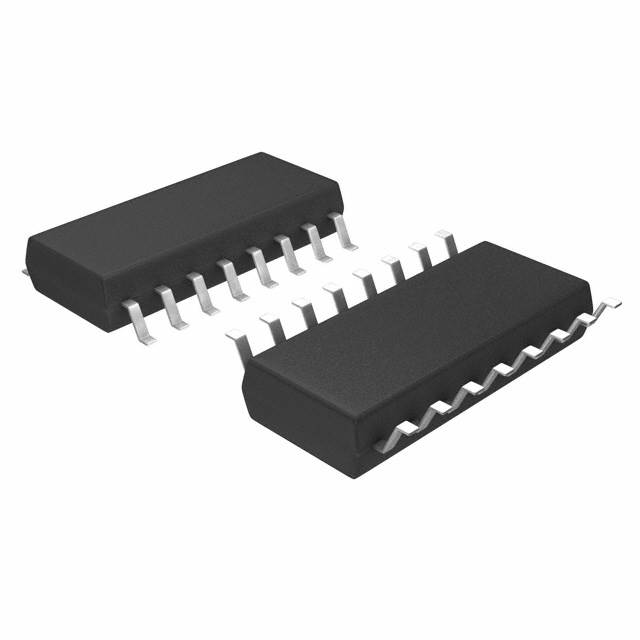Xem thông số kỹ thuật để biết chi tiết sản phẩm.

SN75ALS197NSR
Product Overview
- Category: Integrated Circuit
- Use: Signal Line Driver/Receiver
- Characteristics: High-speed, Low-power, Differential Signaling
- Package: 16-pin SOIC (Small Outline Integrated Circuit)
- Essence: Amplification and Conversion of Digital Signals
- Packaging/Quantity: Tape and Reel, 2500 units per reel
Specifications
- Supply Voltage: 4.5V to 5.5V
- Operating Temperature Range: -40°C to +85°C
- Data Rate: Up to 20 Mbps
- Propagation Delay: 10 ns (typical)
- Output Current: ±15 mA
- Input Voltage Levels: TTL/CMOS Compatible
- ESD Protection: > 2 kV (Human Body Model)
Pin Configuration
The SN75ALS197NSR has a 16-pin configuration as follows:
- VCC
- GND
- B1
- A1
- Y1
- Z1
- Z2
- Y2
- A2
- B2
- ENABLE
- GND
- B3
- A3
- Y3
- Z3
Functional Features
- Differential signaling for noise immunity
- High-speed data transmission
- Low power consumption
- Wide operating temperature range
- ESD protection for robustness
- TTL/CMOS compatible input voltage levels
- Enable pin for power management
Advantages and Disadvantages
Advantages: - High-speed data transfer capability - Low power consumption - Robust ESD protection - Wide operating temperature range
Disadvantages: - Limited data rate compared to newer models - Requires external enable signal for power management
Working Principles
The SN75ALS197NSR is a signal line driver/receiver integrated circuit that amplifies and converts digital signals. It operates on a supply voltage of 4.5V to 5.5V and supports data rates up to 20 Mbps. The device uses differential signaling, which provides noise immunity and enables high-speed data transmission.
The input voltage levels are compatible with both TTL and CMOS logic families. The output current capability is ±15 mA, allowing the device to drive long transmission lines without significant signal degradation. The integrated ESD protection ensures the device's robustness against electrostatic discharge events.
The SN75ALS197NSR features an enable pin that allows for power management. When the enable pin is low, the device enters a low-power standby mode, reducing power consumption.
Detailed Application Field Plans
The SN75ALS197NSR is commonly used in various applications that require high-speed data transmission over long distances. Some of the typical application fields include:
Industrial Automation: The device is used in industrial control systems to transmit digital signals between sensors, actuators, and control units. Its noise immunity and high-speed capabilities make it suitable for harsh industrial environments.
Telecommunications: The SN75ALS197NSR is utilized in telecommunications equipment for transmitting digital signals between different network components. It ensures reliable data transfer and minimizes signal degradation over long distances.
Automotive Electronics: In automotive applications, the device is employed for communication between various electronic modules, such as engine control units, body control modules, and infotainment systems. Its wide operating temperature range makes it suitable for automotive environments.
Medical Devices: The SN75ALS197NSR finds use in medical devices that require high-speed data transmission, such as patient monitoring systems and diagnostic equipment. Its low power consumption is beneficial for battery-powered devices.
Detailed and Complete Alternative Models
- SN65ALS197: Similar to SN75ALS197NSR, but with a wider supply voltage range (3V to 5.5V).
- SN75ALS195: Lower-cost alternative with reduced data rate (up to 10 Mbps) and no enable pin.
- SN65ALS176: Differential line driver/receiver with higher data rate capability (up to 50 Mbps) and extended temperature range (-55°C to +125°C).
These alternative models offer different features and specifications to cater to specific application requirements.
Word count: 511 words
Liệt kê 10 câu hỏi và câu trả lời thường gặp liên quan đến ứng dụng SN75ALS197NSR trong giải pháp kỹ thuật
Sure! Here are 10 common questions and answers related to the application of SN75ALS197NSR in technical solutions:
Q: What is SN75ALS197NSR? A: SN75ALS197NSR is a quad differential line driver IC that is commonly used for driving high-speed data transmission over long distances.
Q: What is the operating voltage range of SN75ALS197NSR? A: SN75ALS197NSR operates within a voltage range of 4.5V to 5.5V.
Q: What is the maximum data rate supported by SN75ALS197NSR? A: SN75ALS197NSR supports a maximum data rate of 40 Mbps.
Q: Can SN75ALS197NSR be used for both single-ended and differential signaling? A: No, SN75ALS197NSR is specifically designed for differential signaling applications.
Q: What is the typical output voltage swing of SN75ALS197NSR? A: The typical output voltage swing of SN75ALS197NSR is around 3.3V.
Q: Does SN75ALS197NSR have built-in protection features? A: Yes, SN75ALS197NSR has built-in thermal shutdown and short-circuit protection features.
Q: Can SN75ALS197NSR be used in industrial environments? A: Yes, SN75ALS197NSR is suitable for use in industrial environments due to its robustness and reliability.
Q: What is the recommended PCB layout for SN75ALS197NSR? A: It is recommended to follow the guidelines provided in the datasheet for proper PCB layout, including proper grounding and signal routing techniques.
Q: Can SN75ALS197NSR be used in automotive applications? A: Yes, SN75ALS197NSR is automotive qualified and can be used in automotive applications.
Q: Are there any evaluation boards available for SN75ALS197NSR? A: Yes, Texas Instruments provides evaluation boards that can be used to test and evaluate the performance of SN75ALS197NSR in different applications.
Please note that these answers are general and it is always recommended to refer to the datasheet and application notes provided by the manufacturer for specific details and guidelines.

